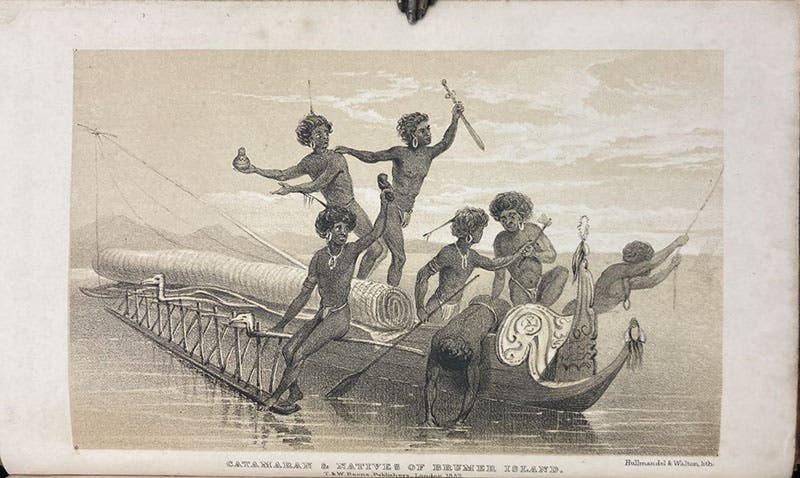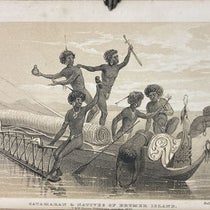Scientist of the Day - Barbara Crawford Thompson

Torres Strait Islanders, similar to as those who rescued Barbara Crawford Thompson from a shipwreck and took her to Muralag Island, lithographed frontispiece, Narrative of the Voyage of H.M.S. Rattlesnake, commanded by the late Captain Owen Stanley... during the years 1846-50, by John MacGillivray, vol. 1, 1852 (Linda Hall Library)
On Oct. 16, 1849, some of the crew of HMS Rattlesnake were on the beach at Cape York, the northernmost tip of the Australian peninsula, which sticks up into the Torres Strait towards New Guinea. The ship was near the end of a four-year exploration and mapping of the Strait and the Great Barrier Reef, looking for shipping lanes and supposedly studying the natural history of the area and learning about the Torres Strait Islanders who inhabited the region, although Captain Owen Stanley’s timidity had restricted the activity of the scientists aboard, to their great irritation. These included Thomas H. Huxley, just starting out on what would be an illustrious career in zoology, and the botanist John MacGillivray. Also aboard was artist Oswald Brierly, who provided one of the few images we have of the Rattlesnake in Australia.
On this particular morning, Oct. 16, 1849, a crew replenishing the ship's water supply was met on the beach by several islanders escorting a woman who, although darkened by the sun, naked, and grimy, appeared to be a white European. She revealed to the astonished sailors, in pidgin English, that her name was Barbara Crawford Thompson, and that she had been shipwrecked 4-5 years earlier and saved from drowning by the very islanders now escorting her. They had taken her to Muralag, an island just north of Cape York, which the British called Western Prince of Wales Island, where she had been adopted by a native family and welcomed into the community there. It was at her request that her rescuers were now giving her up to the crew of the Rattlesnake.

Detail of map of Torres Strait, showing the tip of Cape York. The island with “Wales” printed on it is Muralag, where Barbara Crawford Thompson was taken by Islanders after her shipwreck, folding engraving in Narrative of the Voyage of H.M.S. Rattlesnake, commanded by the late Captain Owen Stanley... during the years 1846-50, by John MacGillivray, vol. 1, 1852 (Linda Hall Library)
The next few days onboard ship were exciting, even mind-boggling, as Mrs. Thompson slowly regained her English tongue and her story came out. She was Scottish by birth and had moved to Sydney when she was 8 or so. When she was 15-16, she had run away with a sailor, and they had moved north to Moreton Bay in Queensland, where she lived as his common-law wife. One day her husband heard about a ship full of whale oil that had foundered up near New Guinea, which he hoped to salvage and make them rich. But the cutter they took north struck a reef in the Torres Strait, and everyone drowned except Barbara, who was rescued by the two Islanders. She had been well-treated on Muralag. She was now about 20-21 years of age.

The beginning of chapter 8, where the story of the encounter with “the white woman” Barbara Crawford Thompson begins, Narrative of the Voyage of H.M.S. Rattlesnake, commanded by the late Captain Owen Stanley... during the years 1846-50, by John MacGillivray, vol. 1, p. 301, 1852 (Linda Hall Library)
The member of the crew who was most interested in Barbara's story was Brierly, who interviewed her for weeks, even after the ship had set sail for a final reconnoiter in the Strait. He asked her about the lifestyle of the Kaurareg peoples on Muralag who adopted her, quizzing her on their religion, taboos, rites, all of which he recorded in his journal, which he, inexplicably, never published. It was finally edited and printed in 1977.
The Rattlesnake finally made it back to Sydney on Feb. 5, 1850, and Barbara was picked up by friends and taken to be reunited with her parents. The crew never heard from her again. It is thought that Barbara Crawford Thompson married twice more and died in 1916, at the age of about 87. The location of her grave is unknown.
The world at large first learned about Mrs. Thompson when John MacGillvray published Narrative of the Voyage of H.M.S. Rattlesnake in 1852. He was called upon to write the account when Captain Stanley died suddenly soon after getting back to Sydney. We have MacGillivray's narrative in our collections; it is a two-volume work, with attractive tinted lithographs, mostly based on drawings by Huxley. We showed some of these in our second post on Huxley.
MacGillivray's account of the encounter with Barbara Crawford Thompson seems distorted – he made her into more of a prisoner than she seems to have been – and even more curious is the fact that he provided no portrait of Mrs. Thompson – surely Brierly and/or Huxley must have sketched her. Perhaps there was a stipulation by Thompson that she not be portrayed. Whatever the reason, we have no image of her at all.
The most curious aspect of the entire affair is how thoroughly Barbara Crawford Thompson disappeared from the historical record. It has been speculated that because she was not tortured or raped nor were her companions roasted and devoured, there was no public interest in her survival. It probably did not help that Mrs. Thompson apparently had no desire to be a celebrity. Whatever the reason, she rapidly became a historical footnote and dead end.
The most reliable modern source on the voyage and its encounter with Barbara Thompson is The Rattlesnake: A Voyage of Discovery to the Coral Sea, by Jordan Goodman (Faber & Faber, 2005).
William B. Ashworth, Jr., Consultant for the History of Science, Linda Hall Library and Associate Professor emeritus, Department of History, University of Missouri-Kansas City. Comments or corrections are welcome; please direct to ashworthw@umkc.edu.








